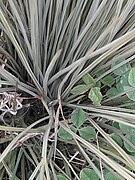Biology:Aciphylla subflabellata
| Aciphylla subflabellata | |
|---|---|

| |
| Aciphylla subflabellata in Dunedin Botanic Garden | |
| Scientific classification | |
| Kingdom: | Plantae |
| Clade: | Tracheophytes |
| Clade: | Angiosperms |
| Clade: | Eudicots |
| Clade: | Asterids |
| Order: | Apiales |
| Family: | Apiaceae |
| Genus: | Aciphylla |
| Species: | A. subflabellata
|
| Binomial name | |
| Aciphylla subflabellata W.R.B.Oliv.[2]
| |
Aciphylla subflabellata is a species of speargrass in the genus Aciphylla.
Taxonomy & naming
Walter Oliver first described the plant in 1956, from a type specimen collected Waiau tussock grassland.[3] Its specific epithet means "somewhat fan-like".[4]
Description
This species is a perennial herb that forms stout rosettes of spiky leaves reaching 50—80 cm.[4][5] The leaves are distinctive for being fan-like and flattened: the leaf pinnae are set close together, and are roughly in the same plane as the leaf axis.[4]
The flowering stem is up to 1 m tall and 25 mm wide, with a 50–60 cm inflorescence. The yellow flowers appear from December to February, and the wind-dispersed seeds in February to May.[4]
In his description Oliver noted that this species was most similar to A. squarrosa in its narrow leaves and downturned terminal bract segments, but the finely-toothed terminal bracts are much longer (up to 30 cm) and the leaves are always bipinnate.[3] A. subflabellata has more finely-divided and flattened leaves than A. squarrosa, and is usually much smaller.[4]
Distribution
A. subflabellata is restricted to the South Island of New Zealand from south-eastern Marlborough to Southland, from 300 to 1400 m. It prefers dry subalpine sites, and is sometimes found amongst rocks.[4]
Conservation
This species' status under the Department of Conservation's NZTCS system is "At Risk – Declining"[1] It may be naturally uncommon over most of its range, but much of its habitat has been modified for pastoral farming and like most Aciphylla it is vulnerable to browsing by stock, rabbits, and hares.[4]
References
- ↑ 1.0 1.1 "Aciphylla subflabellata". https://nztcs.org.nz/assessments/32040.
- ↑ "Aciphylla subflabellata". International Plant Names Index (IPNI). Royal Botanic Gardens, Kew. https://www.ipni.org/n/837243-1.
- ↑ 3.0 3.1 , Wikidata Q89183611
- ↑ 4.0 4.1 4.2 4.3 4.4 4.5 4.6 "Aciphylla subflabellata" (in en). https://www.nzpcn.org.nz/flora/species/aciphylla-subflabellata/.
- ↑ "Flora of New Zealand | Taxon Profile | Aciphylla subflabellata". https://www.nzflora.info/factsheet/Taxon/Aciphylla-subflabellata.html.
External links
- iNaturalist observations of Aciphylla subflabellata
Wikidata ☰ Q15558520 entry
 |






